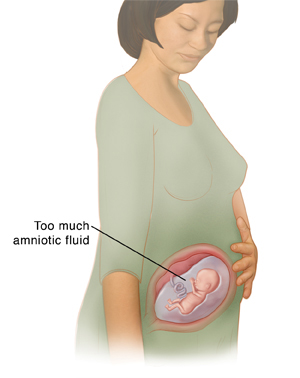Polyhydramnios
Polyhydramnios
Amniotic fluid surrounds the fetus and protects it as it develops. It also helps the baby’s muscles, lungs, and digestive tract develop properly. Your healthcare provider has determined that you have too much amniotic fluid in the womb. This is called polyhydramnios. The problem is often easily managed.
Causes of polyhydramnios
Polyhydramnios may be more common in women with diabetes or certain other health problems. A health problem in the fetus may also be a cause. In more than half the cases, though, the cause of the high fluid levels is not known.
Diagnosing polyhydramnios
An ultrasound is done to measure the amount of amniotic fluid in the womb. The ultrasound uses sound waves to create detailed images of the inside of the womb. During the ultrasound test, the amount of amniotic fluid is measured, most often through a method called amniotic fluid index (AFI).
Managing polyhydramnios
Polyhydramnios usually doesn't go away on its own. Most issues that cause polyhydramnios don't correct themselves and will need to be treated. Your healthcare provider will do regular ultrasounds to monitor your amniotic fluid level. Regular prenatal care is also done to check the health of your baby. In many cases, no treatment is needed. If your healthcare provider decides that treatment is necessary, it may include:
Medicines to help decrease the amount of fluid being produced. They are rarely used beyond 32 weeks.
Amnioreduction to drain excess fluid from the womb. This is done during amniocentesis.
Induction of labor may be done if the pregnancy is at term or beyond. Your healthcare provider will tell you more, if needed.
Follow-up care
If you or the fetus has a condition that has caused the high amniotic fluid level, the condition will be treated. Sometimes, an issue involving the fetus can't be treated until after delivery. Your healthcare provider can tell you more about the cause of your high amniotic fluid level. He or she can also discuss any needed treatments with you.
Call your healthcare provider
Contact your healthcare provider right away if you have any of the following:
Fever of 100.4°F (38°C) or higher
Sudden or severe abdominal cramping
Fluid leaking from the vagina
Regular, rhythmic contractions
Baby moving less than usual
Updated:
October 11, 2018
Sources:
Polyhydramnios. UpToDate
Reviewed By:
Burd, Irina, MD, PhD,Goode, Paula, RN, BSN, MSN
